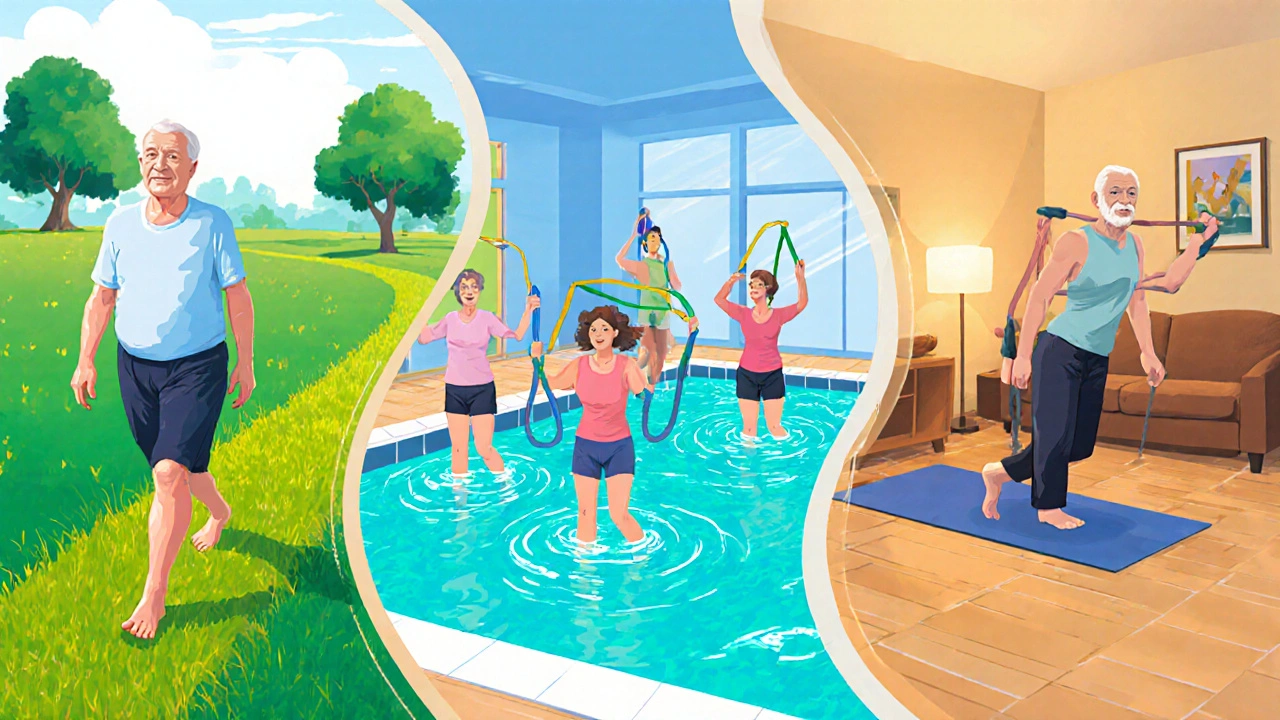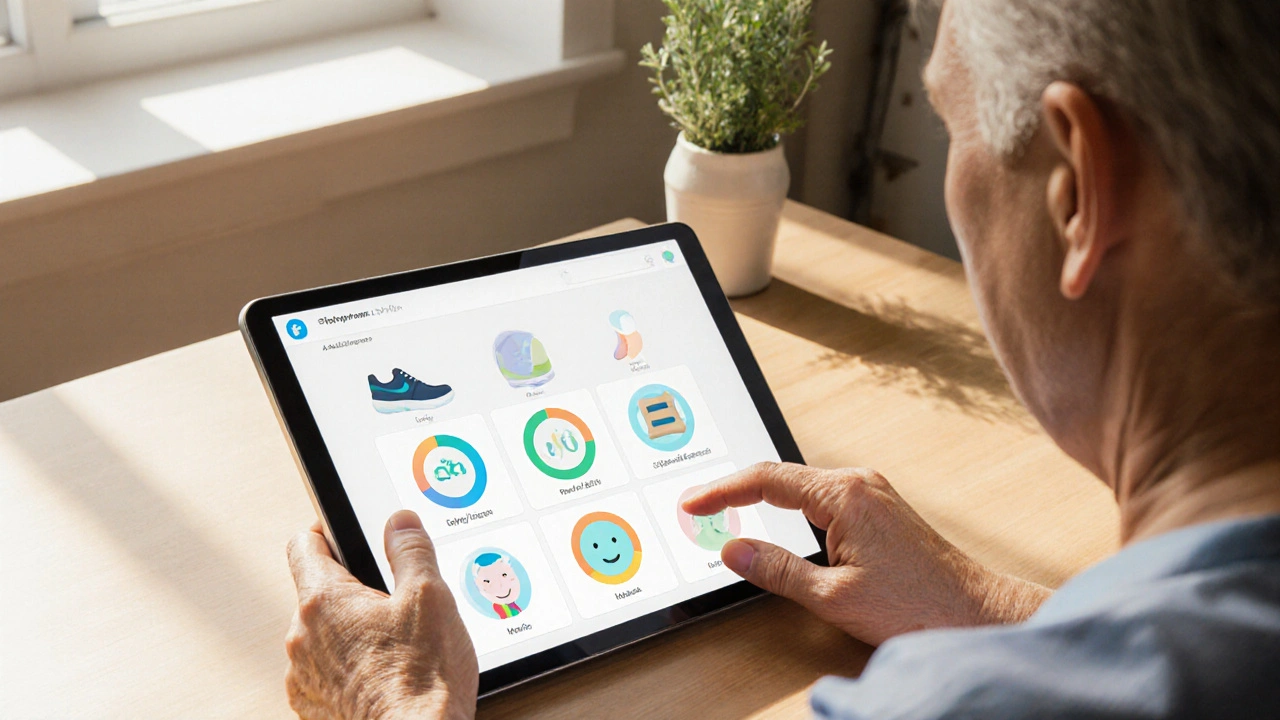Osteoarthritis Coping Strategy Planner
Answer the questions above to see your personalized coping strategy assessment.
Living with osteoarthritis can feel like a constant tug‑of‑war between what your body wants to do and what your joints will allow. When the knees, hips, or hands start hurting, everyday tasks-from climbing stairs to holding a coffee mug-can become battles that drain energy and mood. The good news is that targeted coping strategies can shift the balance, letting you reclaim a fuller, more comfortable life.
Key Takeaways
- Osteoarthritis impacts physical, emotional, and social aspects of quality of life.
- Safe physical activity, weight control, and joint‑protective habits are foundational.
- Effective pain management blends medication, heat/cold therapy, and mindset tools.
- Occupational therapy and assistive devices restore independence.
- A personalized, multi‑component plan yields the best long‑term results.
How Osteoarthritis Affects Quality of Life
Osteoarthritis is a degenerative joint disease that gradually erodes cartilage, causing pain, stiffness, and reduced mobility. While the condition commonly appears after the age of 45, its prevalence is climbing worldwide due to aging populations and rising obesity rates.
The ripple effect reaches beyond the joints. Chronic pain interferes with sleep, limits social activities, and can trigger anxiety or depression. When a beloved hobby-like gardening or dancing-becomes painful, a sense of loss creeps in, dragging down overall quality of life. Studies from 2023 show that people with moderate‑to‑severe osteoarthritis report a 30% lower health‑related quality‑of‑life score compared to peers without the disease.
Physical Activity: Move Smart, Feel Better
Staying active is the single most powerful tool for slowing joint degradation and easing pain. The key is to choose low‑impact activities that strengthen muscles without overloading the joint.
- Walking on soft surfaces-like tracks or grass-improves circulation and keeps joints lubricated.
- Water aerobics-the buoyancy of water reduces load while allowing a full‑range workout.
- Strength training-focus on major muscle groups surrounding affected joints, using resistance bands or light weights.
- Flexibility routines-gentle yoga or tai chi can increase range of motion and reduce stiffness.
Start with 10‑minute sessions three times a week, then gradually increase duration by 5minutes every two weeks. Always warm up with a 5‑minute low‑intensity walk and finish with gentle stretching to prevent flare‑ups.
Weight Management: Lightening the Load
Every extra pound adds roughly four pounds of pressure on the knees and six pounds on the hips. Even a modest 5% body‑weight loss can cut knee‑joint pain by up to 30%.
Combine a balanced Mediterranean‑style diet-rich in fruits, vegetables, whole grains, lean protein, and healthy fats-with regular physical activity. Track calories using a simple app, aim for a deficit of 500kcal per day, and monitor progress weekly. For many, partnering with a registered dietitian accelerates adherence and results.

Pain Management Options
Effective pain control often requires a layered approach. Below are the most evidence‑based options.
- Medication-acetaminophen, NSAIDs (ibuprofen, naproxen), and, when needed, low‑dose duloxetine for chronic pain.
- Topical agents-capsaicin or diclofenac gels applied directly to the sore area provide localized relief with fewer systemic side effects.
- Heat and cold therapy-warm packs relax stiff joints before activity; ice packs reduce swelling after exertion.
- Intra‑articular injections-corticosteroids for short‑term flare control; hyaluronic acid for lubrication in some cases.
- Mind‑body techniques-guided imagery, deep breathing, and progressive muscle relaxation can lower perceived pain intensity.
Always discuss medication choices with a healthcare professional, especially if you have cardiovascular or gastrointestinal concerns.
Occupational Therapy & Assistive Devices
Occupational therapy helps translate medical advice into everyday reality. A therapist can teach joint‑protective techniques for dressing, cooking, and typing, and recommend tools that reduce strain.
Common assistive devices include:
| Device | Primary Goal | Typical Use |
|---|---|---|
| Jar openers | Reduce grip force | Opening food containers |
| Long‑handled reachers | Minimize bending | Picking up items from floor |
| Ergonomic kitchen tools | Maintain neutral wrist position | Cutting, stirring |
| Walking cane or quad stick | Improve balance | Ambulation outdoors |
| Compression sleeves | Provide joint support | During activity or rest |
Trial periods are often covered by health insurers, so ask your therapist for a short‑term loan before committing to purchase.
Psychological Support & Mental Well‑Being
Living with chronic pain can erode confidence and lead to social withdrawal. Psychological support-whether through counseling, support groups, or psychotherapy-helps reframe pain narratives and develop resilient coping skills.
Evidence from 2022 shows cognitive‑behavioral therapy (CBT) reduces pain‑related disability by 20% and improves mood scores in osteoarthritis patients. Even brief weekly check‑ins with a mental‑health professional can boost motivation to stay active and adhere to treatment plans.
Building Your Personal Coping Plan
- Assess baseline: Use a simple questionnaire (e.g., WOMAC) to gauge pain, stiffness, and functional limitation.
- Set realistic goals: Aim for specific outcomes like “walk 30minutes without pain spikes three times a week” rather than vague “be more active.”
- Choose core strategies: Pick at least one activity, one nutrition goal, and one pain‑relief method that fit your lifestyle.
- Create a schedule: Block dedicated time for exercise, meal prep, and relaxation-treat these blocks like medical appointments.
- Monitor and adapt: Keep a weekly log of pain levels, activity duration, and mood. Adjust intensity or techniques based on trends.
- Seek professional input: Schedule quarterly reviews with a physio, dietitian, or occupational therapist to fine‑tune the plan.
By combining movement, weight control, targeted pain relief, adaptive tools, and mental‑health support, you create a multi‑layered shield against the daily grind of osteoarthritis. These Osteoarthritis coping strategies empower you to stay active, engaged, and hopeful.
Frequently Asked Questions
Can I exercise if I have severe knee pain?
Yes, but choose low‑impact options like water aerobics or stationary cycling, and keep sessions short (5‑10minutes) until pain improves. A physio can tailor a program that protects the joint while building strength.
Are over‑the‑counter NSAIDs safe for long‑term use?
Occasional use is generally safe, but chronic daily use can upset the stomach and affect kidney function. Talk to your doctor about the lowest effective dose, possible gastro‑protective meds, or alternative pain relievers.
Do assistive devices make me look “old”?
Not at all. Modern designs are sleek and discreet. More importantly, they preserve independence and prevent falls, which is far more valuable than any aesthetic concern.
How much weight loss is needed to feel better?
A 5‑10% reduction in body weight often yields noticeable pain relief. For someone weighing 90kg, losing 5‑9kg could cut knee‑joint load dramatically.
Is depression common among osteoarthritis patients?
Yes. Chronic pain and reduced mobility raise the risk of depression by about 30% compared to the general population. Early counseling or CBT can mitigate this risk.

Debra Laurence-Perras
October 1, 2025 AT 12:43Living with osteoarthritis can feel overwhelming, but small, consistent steps make a big difference. Try to fit a gentle walk into your routine at least a few times a week; your joints will thank you for the movement. Pair that with a balanced diet, and you’ll notice improvements in both pain levels and mood. Keep a positive outlook, and remember that every effort counts toward a better quality of life.
dAISY foto
October 8, 2025 AT 11:23Oh wow, the struggle is real! But hey, picture yourself gliding through a pool – splash, splash, and the pain just melts away. Keep that fire burning, you got this!
Ian Howard
October 15, 2025 AT 10:03When we talk about osteoarthritis, the first thing to acknowledge is that it’s not just a physical ailment; it’s a multidimensional experience that affects every facet of daily living.
Understanding the disease process helps demystify the pain and empowers us to make informed choices.
First, consider low-impact aerobic activities such as swimming, cycling, or brisk walking – these keep the joints lubricated without the pounding forces that high‑impact sports impose.
Second, maintaining a healthy weight reduces the mechanical load on weight‑bearing joints, which can dramatically lower pain scores.
Third, pain management isn’t limited to medication; the synergistic use of heat packs, cold compresses, and guided relaxation techniques can break the pain‑stress cycle.
Fourth, assistive devices like cane or brace are not signs of weakness but tools that preserve function and prevent further damage.
Fifth, mental well‑being plays a crucial role; chronic pain often spirals into anxiety or depression, which in turn heightens pain perception.
Incorporating mindfulness, gentle yoga, or even a simple breathing routine can reset that vicious loop.
Moreover, nutrition shouldn’t be overlooked – a diet rich in omega‑3 fatty acids, antioxidants, and vitamin D supports joint health and reduces inflammation.
Regular check‑ins with a healthcare professional ensure that treatment plans stay personalized and responsive to changes.
Community support groups offer shared experiences, reducing the sense of isolation that many patients feel.
Technology can assist, too; smartphone apps for activity tracking and pain journaling help visualize patterns and progress.
Remember, consistency beats intensity; a short daily walk is more beneficial than a marathon once a month.
Celebrate small victories – a day with less stiffness, a longer walk, or a night of uninterrupted sleep.
These incremental gains compound over time, leading to a noticeable uplift in overall quality of life.
Finally, stay curious and proactive; the field of osteoarthritis management is evolving, and new therapeutic options emerge regularly.
David Stout
October 22, 2025 AT 08:43Great points above, and let’s add a dash of inclusive mindset. Invite a friend to join you for a low‑impact class – accountability works wonders.
Mix up activities: a bit of water aerobics, a gentle hike, and some chair yoga to keep things fresh.
When it comes to weight, think of nutrition as fuel, not restriction; small swaps add up.
And never underestimate the power of positive self‑talk; you’re steering your own journey.
Pooja Arya
October 29, 2025 AT 06:23It is a moral imperative to recognize that neglecting one’s joint health is a betrayal of the body’s sacred contract. Every ache demands introspection, urging us toward disciplined self‑care. In the grand theater of existence, we must play the role of the vigilant steward, not the indifferent spectator. Choose wisely, for the consequences echo beyond the momentary discomfort.
Sam Franza
November 5, 2025 AT 05:03Move daily.
Raja Asif
November 12, 2025 AT 03:43Honestly, most of these “strategies” are just fluff designed for western audiences. True relief comes from embracing robust, traditional practices that actually strengthen the body, not these half‑baked Western wellness trends.
Matthew Tedder
November 19, 2025 AT 02:23I hear you, and I think staying grounded is key. Gentle routines that respect personal limits can build confidence over time. Listening to one’s body, rather than pushing through pain, is a form of self‑compassion. Let’s keep sharing practical tips that foster real improvement.
Cynthia Sanford
November 26, 2025 AT 01:03Hey there! Just wanted to say you’re doing awesome – keep those low‑impact workouts coming! Even a short stroll can lift your spirits big time.
Yassin Hammachi
December 2, 2025 AT 23:43Balancing activity with rest is subtle but essential. It’s not about overexertion; it’s about mindful consistency. Integrating brief meditation sessions can lower stress‑induced inflammation. Together, these habits create a harmonious environment for joint health.
Michael Wall
December 9, 2025 AT 22:23One must remember that personal responsibility is the foundation of any health plan. Simple actions, such as walking or mindful breathing, are effective without unnecessary complexity.
Irene Harty
December 16, 2025 AT 21:03It is evident that the prevailing medical discourse is tainted by undisclosed influences, rendering the offered coping strategies questionable at best. A critical examination of underlying motives is essential before embracing such recommendations.